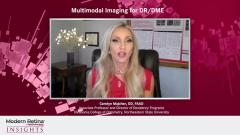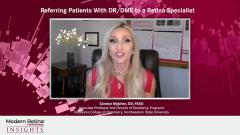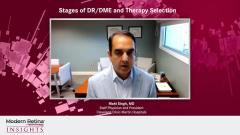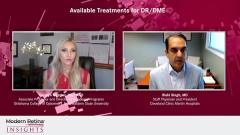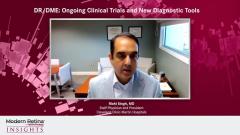
Diagnostic Challenges of DR/DME
Carolyn Majcher, OD, FAAO, describes challenges primary eye care providers can experience when diagnosing diabetic retinopathy and diabetic macular edema (DR/DME).
Episodes in this series

Rishi Singh, MD: What challenges do you and other primary care eye doctors face, with regards to diagnosing this condition? You said all these technologies are out there, but is that really what all we need, is just technology?
Carolyn Majcher, OD, FAAO: No, certainly there's a lot of other challenges we face as well. Sometimes the challenge is not having the technology, unfortunately. It's expensive, and we don't always have access to all the bells and whistles of OCT [optical coherence tomography] angiography, so that's certainly a challenge. But I think other challenges would be, and we've probably all experienced firsthand, that accurate and precise staging of diabetic retinopathy can be a challenge in a clinical setting when you have a patient that's maybe a poor fixator or has media opacity, significant photophobia, they can't keep their eyes open. There are instances, if technology is not available, you're uncertain what the stage of retinopathy is. In general, we would tend to underclassify the stage of retinopathy. For example, saying a patient has severe non-proliferative retinopathy when in actuality, they're proliferative. And this is probably quite common, especially in the severe non-proliferative stage. Probably about one-third of patients that we classify as being severe non-proliferative are actually proliferative.
Something specifically I wanted to bring up was featureless retina, which has been described in the literature as sort of a deceptively quiet fundus. These are eyes that have proliferative disease, but minimal to no background diabetic retinopathy signs like dot hemes or cotton-wool spots. And this misleading clinical presentation of proliferative diabetic retinopathy is probably due to this extensive retinal non-perfusion. So that retina is essentially dead or atrophied away and can't mount a response in terms of hemorrhaging or background signs.
Another challenge is in catching patients at the time they need to be referred for treatment. There’s difficulty in identifying those patients that are going to progress very fast in the disease, and therefore setting a follow-up schedule for them that's appropriate so that you can catch them when they hit severe non-proliferative and can refer them out appropriately. So, I think it's really important for us to try to identify in our examination risk factors for progression; long duration of the disease, poor glycemic control, comorbidities as you were mentioning earlier like hypertension, and dyslipidemia. Sleep apnea is another big one. If [the patient] has a history of noncompliance or is monocular, then I'm going to watch them a lot more closely as well. And then lastly, another challenge we face in diagnosing diabetic retinopathy in a timely manner is simply getting patients in our exam chair before it's too late. Unfortunately, only about 60% of Americans adhere to recommendations for annual eye examinations, and many patients with diabetes just don't even know that diabetes can affect their eyes, unfortunately.
TRANSCRIPT EDITED FOR CLARITY
Newsletter
Keep your retina practice on the forefront—subscribe for expert analysis and emerging trends in retinal disease management.


